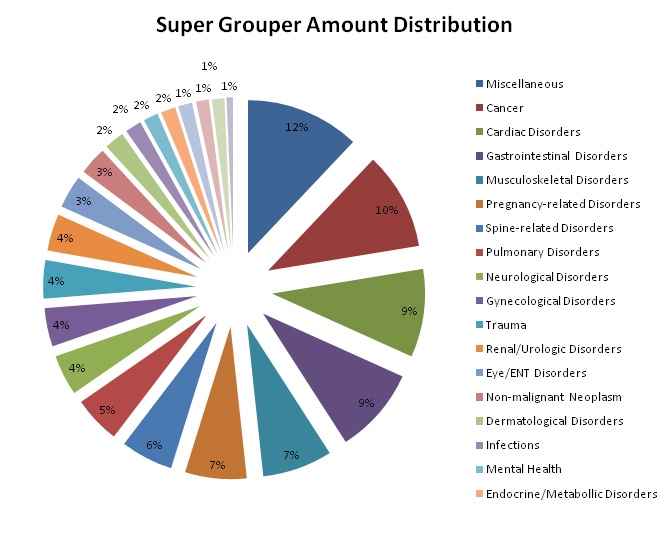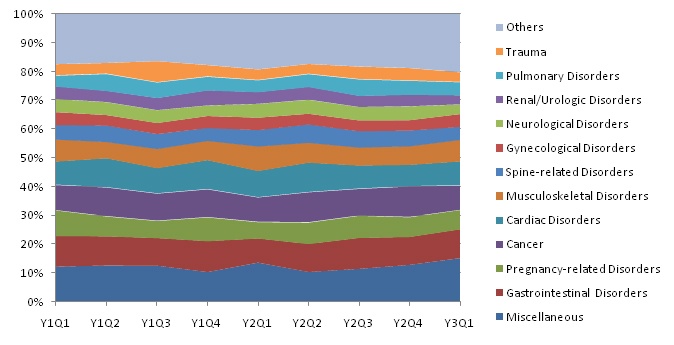Deerwalk Diagnosis Groupers
Introduction
Deerwalk recently released version 1.0 of its Diagnosis Groupers. Specifically, enhancements in the 1.0 release focus on the expansion of the number of Diagnosis Groupers and “Super Groupers”. The new Diagnosis Groupings allow the users of Deerwalk products more specificity when using Diagnosis Groupers in data searches and reporting; while the Super Groupers ease reporting when done at an aggregate diagnosis level.
Problem Statement
The Diagnosis Groupers developed by Deerwalk was bundled in the initial release of its product, Makalu, in January 2012. These Diagnosis Groupers provide support for the reporting categories and quality metrics that our clients frequently need. Moreover, since many of our clients use “home-grown” codes, being able to assign these non-standard diagnosis codes to standardized groupers allows them to easily incorporate these codes into reports and analytics.
Since the roll out of the Groupers in January 2012, we, at Deerwalk, have been evaluating the performance of our Diagnosis Groupers in meeting the clients’ analytic and reporting needs. In particular, we have been looking at how our clients use our products as well as the level of detail required by the client in relation to diagnoses. In some instances, clients needed codes at an individual code level, while in others related diagnosis codes rolled up into an aggregate single grouping was the most appropriate. Based on these observations, we determined the modifications to be made to the way the diagnoses were being grouped that would result in enhanced performance.
Solution
Our clinical team has experience not only in using several of the available commercial Diagnosis Groupers, but also in developing custom groupers. The team evaluated the benefits as well as the drawbacks of building versus buying Diagnosis Groupers, taking into consideration not only the cost and resources required, but also the usefulness of the groupings in meeting our clients’ needs. The key factor in our decision to continue using our own groupers rather than a commercial grouper product was our ability to control the content and revisions with our own groupers. This control would allow us to assign new codes to a grouper as soon as they are released, rather than having to wait for them to be added on an annual basis only. Using Deerwalk-developed Diagnosis Groupers also means that we can quickly and thoroughly answer client’s questions on the grouper logic, such as why specific codes appear in a grouper.
Diagnosis codes were reviewed and evaluated in relation to their use in client reporting, data searches and quality measures in our products. We listened carefully to our clients regarding their grouper and reporting needs, and asked for their feedback on how our existing groupers were performing for them. Well performing groupers were left unchanged, while others were expanded, renamed, added, and in some cases replaced. Grouper and super groupers accuracy and effectiveness were tested against blinded data sets at intervals throughout the process.
Levels of Diagnosis Groupings
In the 1.0 release, there are two levels of diagnosis groupings included:
- Diagnosis Groupers - Each of 17,430 ICD9 diagnosis codes has been individually assigned to one of the 250 Deerwalk Diagnosis Groupers.
- Diagnosis Super Groupers - The 250 Deerwalk Diagnosis Groupers have been rolled up into 22 Super Groupers.
Note
As mentioned previously, many of our clients have “home-grown” diagnosis codes in their data in addition to standard ICD9 codes. When a non-standard code is present in the data, we attempt to map the code to one of our standard groupers. If the code cannot be mapped, it is included in the “Ungroupable” grouper.
The same groupers are used in all of Deerwalk’s products, providing consistency for users and reporting. It is our policy to review our Diagnosis Groupers and Super Groupers at least annually - and sooner, when a need for revisions arises.
Super Groupers
Deerwalk’s Super Groupers include:
| Cancer | Gynecological Disorders | Pregnancy-related Disorders |
| Cardiac Disorders | Hematological Disorders | Pulmonary Disorders |
| Cholesterol Disorders | Infections | Renal/Urologic Disorders |
| Dermatological Disorders | Mental Health | Spine-related Disorders |
| Diabetes | Miscellaneous | Trauma |
| Endocrine/Metabolic Disorders | Musculoskeletal Disorders | Vascular Disorders |
| Eye/ENT Disorders | Neurological Disorders | |
| Gastrointestinal Disorders | Non-malignant Neoplasm |
Example
An example of Diagnosis Super Grouper distribution of a commercial population with 50,000 members is shown in the chart below. This distribution is typical of our grouper performance in our clients’ populations.

A time series output with divisions over how the Diagnosis Super Groupers stack up, on the basis of paid amount is shown below. It shows that the diagnosis distribution is largely consistent over the time period reviewed.

Conclusion
Deerwalk’s clinical team spent six months evaluating the performance of our existing internally developed Diagnosis Groupers in our products. Client input and data analysis using existing client populations were incorporated throughout the process. Well performing groupers were unchanged, while others were expanded, renamed, added and in some cases replaced. Testing of the new Super Groupers and Groupers demonstrated consistent performance across populations. The release of our Diagnosis Groupers V1.0 represents a key step in the evolution of our innovative clinical products.
For more information and access to these groupers, please contact:
Jo Anne Hunt ARNP, CCM
V.P. Clinical Development
Phone: 319-365-0827
Email: jhunt@deerwalk.com
Download PDF

